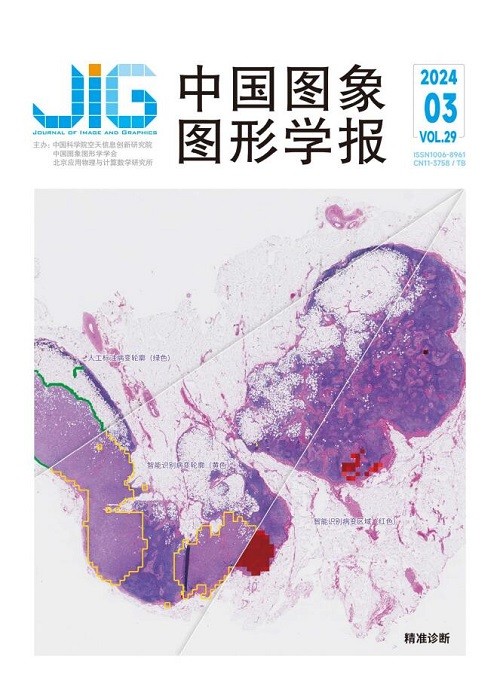
胎儿脑磁共振图像分割研究进展
陈健1, 广梦婷1, 陆冉林1, 罗琴1, 魏丽芳2, 沈定刚3,4(1.福建理工大学电子电气与物理学院, 福州 350118;2.福建农林大学计算机与信息学院, 福州 350002;3.上海科技大学生物医学工程学院, 上海 201210;4.上海联影智能医疗科技有限公司, 上海 200232) 摘 要
医学影像是产前筛查、诊断、治疗引导和评估的重要工具,能有效避免胎儿脑的发育异常。近年来,磁共振成像在产前诊断中愈加重要,而实现自动、定量、精确地分析胎儿脑磁共振图像依赖于可靠的图像分割。因此,胎儿脑磁共振图像分割具有十分重要的临床意义与研究价值。由于胎儿图像中存在组织器官多、图像质量差及结构变化快等问题,胎儿脑磁共振图像的分割面临着巨大的困难与挑战。目前,尚未有文献对该领域的方法进行系统性的总结和分析,尤其是基于深度学习的方法。本文针对胎儿脑磁共振图像分割方法进行综述,首先,对胎儿脑磁共振图像的主要公开图谱/数据集进行详细说明;接着,对脑实质提取、组织分割和病灶分割方法进行全面的分类与分析;最后,对胎儿脑磁共振图像分割面临的挑战及未来的研究方向进行总结与展望。
关键词
Research progress on fetal brain magnetic resonance image segmentation
Chen Jian1, Guang Mengting1, Lu Ranlin1, Luo Qin1, Wei Lifang2, Shen Dinggang3,4(1.School of Electronic, Electrical Engineering and Physics, Fujian University of Technology, Fuzhou 350118, China;2.College of Computer and Information Sciences, Fujian Agriculture and Forestry University, Fuzhou 350002, China;3.School of Biomedical Engineering, ShanghaiTech University, Shanghai 201210, China;4.Shanghai United Imaging Intelligence Co., Ltd., Shanghai 200232, China) Abstract
Medical imaging is an important tool for prenatal screening, diagnosis, treatment guidance, and evaluation, which can effectively avoid abnormal development of the fetal central nervous system, especially for the fetal brain. Medical imaging is mainly operated through X-ray, ultrasound, computed tomography (CT), magnetic resonance imaging (MRI), and other technologies. MRI is a typical non-invasive imaging technology and has become increasingly important for prenatal diagnosis in recent years. MR images are able to produce high tissue contrast, spatial resolution and comprehensive information to facilitate the diagnosis and treatment of the diseases. The automatic measurement of fetal brain MR images can realize the quantitative evaluation of fetal brain development, resulting in improved efficiency and accuracy of diagnoses. The realization of automatic, quantitative, and accurate analysis of fetal brain MR images depends on reliable image segmentation. Therefore, fetal brain MR image segmentation is of vital clinical significance and research value. Owing to the multiple tissues and organs around the fetal brain, poor image quality, and rapid brain structure changes, fetal brain MR image segmentation encounters numerous challenges. This paper summarizes fetal brain MR image segmentation methods. First, the main public atlases and data sets of fetal brain MR images are introduced in detail, including seven publicly available fetal brain MR atlases/data sets. The segmentation labels, acquisition parameters, and some other information of atlases/data sets are described. The links for the atlases/data sets are provided. Second, image segmentation methods, such as brain extraction and tissue/lesion segmentation, are classified and analyzed. Brain extraction methods are categorized into thresholding, region growing, atlas fusion, and classification techniques. Classification techniques are subdivided into traditional machine learning- and deep learning-based methods. Deep learning can automatically learn deep and discriminative features from data, and the performance is significantly improved compared with other methods. Most deep learning-based methods are based on U-Net. And the multi-stage extraction framework is commonly used. Therefore, we further subdivide the deep learning-based methods into single- and multi-stage strategies with U-Net and other convolutional neural networks. Tissue/lesion segmentation methods are categorized into atlas fusion and classification techniques. For the tissue segmentation methods, classification techniques are subdivided into traditional machine learningand deep learning-based methods. Similarly, we further subdivide the deep learning-based methods with U-Net, other convolutional neural networks, and Transformer-based neural networks. In each subsection, we compare the performance of different methods. Lastly, by analyzing the methods, the challenges and future research directions of fetal brain MR image segmentation are summarized and prospected. The conclusions are as follows. 1) One main issue of fetal brain image analysis is that there are only a few publicly available data sets, and the sample size of the available data sets is small. Accordingly, evaluating performance uniformly with private data sets is common. At present, there are only three publicly available data sets, and images for fetal brain lesions are limited. Moreover, some data sets were not annotated. Therefore, lack of annotated data is an issue that seriously restricts the extensive and in-depth application of deep learning-based methods. 2) Data in the existing data sets are insufficient to support clinical application. At present, most existing fetal brain atlases or datasets are collected from 1. 5 T devices. These data have undergone numerous preprocessing operations to derive high-resolution MR images. However, in clinical applications, most images are still the original ones from 1. 5 T devices. In addition, image quality and resolution are significantly different among public atlases/data sets. Consequently, the segmentation models trained via available atlases/data sets cannot be directly applied to clinical images obtained from MRI devices. 3) Although existing deep learning-based methods have been leveraged to fetal brain image segmentation, most references only apply existing deep learning-based methods without sufficient innovation and consideration of the anatomy and image characteristics of fetal brains. 4) The current performance of deep learning-based methods is still unsatisfactory, while the low accuracy of fetal brain extraction and tissue/lesion segmentation will affect the final diagnosis. 5) Most methods do not consider image degradation issues, such as motion artifacts and blurred boundary. 6) Variability in clinical imaging equipment, parameters, and other factors leads to significant differences in fetal brain magnetic resonance images, resulting in limited generalization ability of current segmentation methods. Several possible research directions are presented. 1) Extensive research on automatic annotation is highly required, especially for deep learning-based methods. 2) Additional information on fetal brain, such as anatomical structure and image characteristics, can be further studied. 3) Deep learning-based methods, such as weak supervised, transfer, and self-supervised learning, can be used to compensate for data sets with minimal ground truth or without ground truth. 4) Researchers could combine segmentation methods with super-resolution, motion correction, or design deep networks based on low-quality images to address practical problems of fetal brain MR images. 5) Researchers could enhance the generalization ability of models by combining transfer learning, data augmentation, and training with multimodal data.
Keywords
|



 中国图象图形学报 │ 京ICP备05080539号-4 │ 本系统由
中国图象图形学报 │ 京ICP备05080539号-4 │ 本系统由